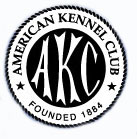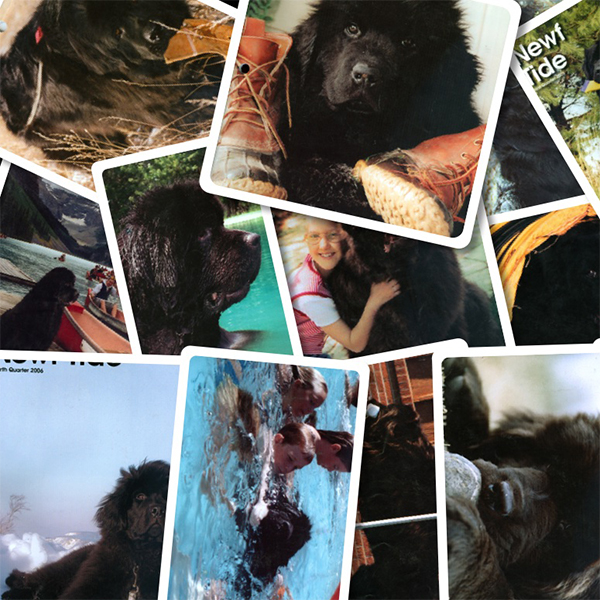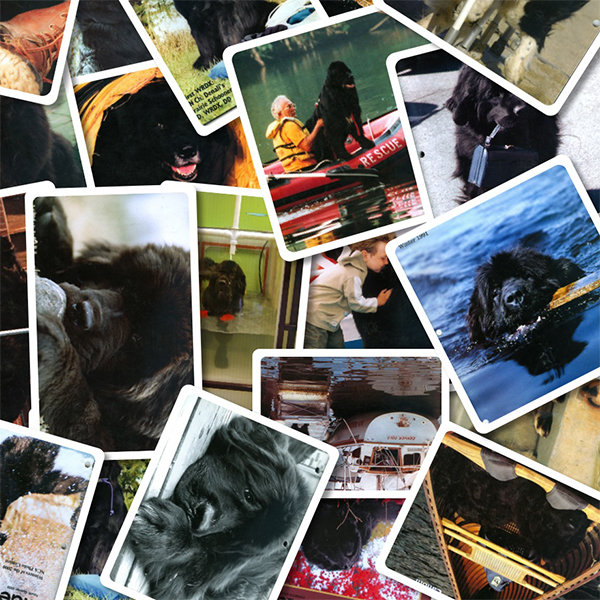
Active in Newfoundlands since the ‘60’s, Louise Esiason served as President of the Newfoundland Club of America for two terms and is an Honorary Member of the NCA.
The Newfoundland dog! If you are looking for lots of love and companionship, look no further! And what a great working dog it is. Many people are involved with this dog and his ability to perform in obedience, water rescue, draft work, and agility. We as breeders have a responsibility to protect the Newfoundland’s ability to perform these tasks.
One of my major concerns is coat. There are other problems we could discuss, but my concern now is coat. Over the past several years I have seen a change in coats that I don’t believe is good for the Newfoundland and surely is contrary to what the standard says a Newfoundland coat should be. There are too many open coats, coats that are too long, and too many sculpted coats. Coats that are scissored well beyond the standard’s “may be trimmed for neatness.” Except on an occasional puppy, until recently I never saw so much coat on top of the head! I saw a Newfoundland in the ring with coat that appeared to grow, or was trained to grow forward on the top of the head and then was scissored into a crewcut. A good Newf head doesn’t need a “Magilla Gorilla” hair-do!
I went back to the writings of some of the most respected breeders of all time. Kitty Drury says: “The Newfoundland is a double coated dog. The outer coat should be straight, flat and of a coarse but not harsh or wiry texture.” She ends her comments by saying: “The whole coat of the dog should adhere to its original purpose of protecting the dog the long, cold winters and the icy waters surrounding his native island.” (Pages 197-199 “This Is The Newfoundland”) Margaret Booth Chem states: “Correct body coat is important to the Newfoundland. Emphasis, however, should be on density rather than length. An overly long or shaggy coat would collect snow and ice and would not be serviceable in winter weather. In the winter, in northern climates, the body should be covered with a fine wooly undercoat. The outercoat should be coarse, straight and lie flat. If brushed the wrong way it should tend to fall back into place. A fluffy or wooly outercoat would not shed water and is strictly against the standard.” (Page 104, The New Complete Newfoundland”) Other writers and our standard say the same things.
Newfoundlands with open coats can be sculpted to create the image of the perfect dog and are often lovely to behold in the ring, but we must remember that this is a working dog and there are good reasons for breeding for proper coat. Roger Powell, in his essay “Coats” in NewfTide, Second Quarter, 1999 states eloquently the problems incorrect coats can cause for a Newfoundland working in cold, snowy conditions.
A number of prominent judges have sounded the alarm. I have had discussions with some judges who are concerned, but since my memory won’t allow me to quote them verbatim I will just remind you that judges at recent National Specialties have expressed concern in their written comments published in that year’s NewfTide. Dorothy Welsh commented that she looked for “a water resistant, double coat, powerful reach and drive, and condition that would allow for work.” She “checked to make sure that each dog could swim easily, not freeze, and not be sculpted to make lines appear correct.” Keke Khan commented: “The winners bitch from the Open Other Than Black class was truly a balanced Newfoundland……. plus a completely correct textured coat. …… I do not like to comment harshly but I feel there are two areas where yourbreeders need to pay more attention. …….. Another area I wish you would help judges on is the over-scissoring. It is just plain wrongand I ask you to please stop doing it.” Donna Buxton also cautioned us about over trimming, saying “Then were some that Iooked almost sculptured.”
Are we listening? For the sake of the future of a great working breed I hope breeders and exhibitors will work very hard to breed and exhibit to the standard, and not get caught up in fads. - L.E.

